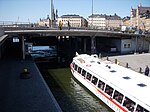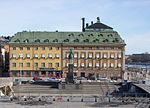Katarina Elevator
1883 establishments in SwedenBuildings and structures in StockholmIndividual elevatorsTransport in StockholmTransport infrastructure completed in 1883

The Katarina Elevator or Katarina Lift (Swedish: Katarinahissen) is a passenger elevator in Stockholm that connects Slussen (the sluice/lock area) to the heights of Södermalm. The lift was a shortcut between Katarinavägen, Slussen and Mosebacke torg. The original lift was constructed in 1881, but the current structure dates from the rebuilding of the Slussen transport interchange in 1936. The lift has been closed since 2010 due to lack of security in the construction and is planned to reopen in 2023.
Excerpt from the Wikipedia article Katarina Elevator (License: CC BY-SA 3.0, Authors, Images).Katarina Elevator
Slussbrogatan, Stockholm Södermalm (Södermalms stadsdelsområde)
Geographical coordinates (GPS) Address Nearby Places Show on map
Geographical coordinates (GPS)
| Latitude | Longitude |
|---|---|
| N 59.32 ° | E 18.072777777778 ° |
Address
Slussen
Slussbrogatan
104 65 Stockholm, Södermalm (Södermalms stadsdelsområde)
Sweden
Open on Google Maps










